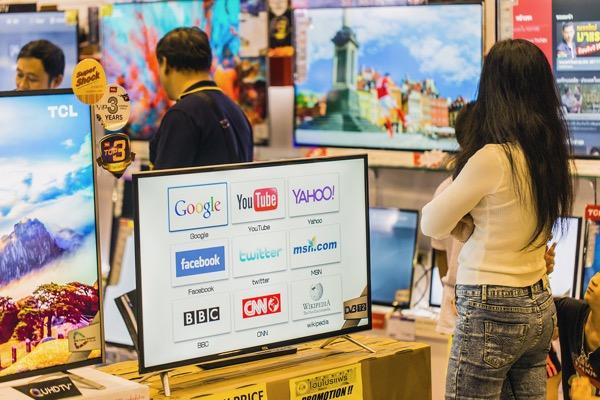TVs, TVs Everywhere

I was reminded of that as I recently visited the TV department in my local Best Buy. Even with Black Friday firmly in the rear-view mirror, there were, quite literally, stacks of boxed TVs filling the aisles. I don’t think I’ve ever seen so many crowded into one space, perhaps not even at CES. And in an area with a population of roughly 100,000, that’s a lot of TVs to sell. Most of them, even the larger models, were well under $1000, reflecting the modest incomes of a primarily middle-class region.
But new TVs are always a hot item, and this is a prime time of year for TV sales. Black Friday notwithstanding, the end of the year holidays, combined with the imminent arrival of the Super Bowl (and the college football championships, with three of the four teams in the playoff having major fan bases in this region), mean that many of those stacked TVs (Best Buy hopes) will have flown out the door by Christmas. In fact, one of my neighbors recently stacked an empty box for a 70-inch set near the curb for trash pickup. (Hint: I know they’re space hogs, but immediately discarding the packing material for your new TV is a very bad idea. What do you do if it fails a few weeks laternot common, but it can happen. Your dealer might not accept a return without the box and its assorted inserts, particularly if the set was on sale.)
TV sales, and prices, do vary widely throughout the year. They’re generally highest when first introduced (the 2018 models won’t show up in stores until late this winter or early spring, after their introduction at the 2018 CES next month). Unless your dealer is desperate, you’ll likely pay close to the MSRP between then and early fall, though there might be a slight sag in the heat of summer when buyers are more preoccupied with sun, sand, and vacations than in watching reruns. When the frost is on the pumpkin, however, and football season begins again, interest picks up. Prices start to sag, culminating in the Wild, Wild West of Black Friday. But television prices then tend to stay down, as both manufacturers and dealers realize that they need to clear out inventory before the 2018 models render the 2017s nearly unsalable to all but barefoot pilgrims (I’m told that’s what care salesmen call naïve buyers who assume they must pay sticker price!).
Should you buy a 2017 set now, knowing that the 2018s are coming soon? It depends on two factors: How much change we’re likely to see in the new sets, and how patient you’ll be. If you buy now, you’ll have that new set now. If you want a 2018 set, you’ll likely have to wait until April or May and will pay those higher, first adopter prices.
Do we expect big things from the 2018 sets? It’s always hard to predict surprises we might see at the January CES, but we don’t see any major changes coming, unlike years when 3D (R.I.P.) or 4K were launched. Will we see any 8K sets? Apart from the inevitable technology demonstration or two, I’d be surprised to see any consumer models with that resolution. The upcoming Olympics will be televised in Japan in 8K, so some manufacturer might be tempted to bring out an 8K set for that market, but there’s been no indication that you’ll be able to see it here in 8K. Moreover, we see no practical future for 8K at all in a domestic setting. Nevertheless, I wouldn’t be surprised to see manufacturers go there eventuallybigger numbers sell regardless of their perceptible benefits. But now? I doubt it.
What we might see are further refinements, including perhaps higher brightness for HDR. But will a 10% or even 20% increase beyond what you can get today be visibly significant? I don’t think so (at least not in flat screen sets; brightness increases will matter more for projectors, and CEDIA is where we usually see new projector introductions, not CES). For now, refinements in other areas are more important. Adding Dolby Vision (and perhaps HDR10+) capability, expanding the available UHD color gamut, adhering more tightly to UHD gamma (the PQ curve), and full array local dimming in LCD/LED sets at consumer-friendly prices will yield more visible results in your living room. We hope to see incremental improvements in those areas, or at least more claimed ones.

























































